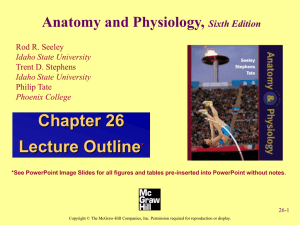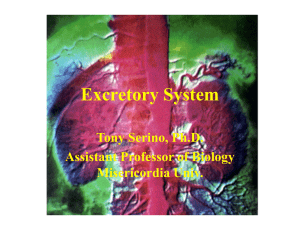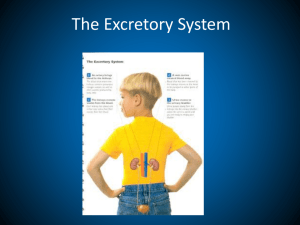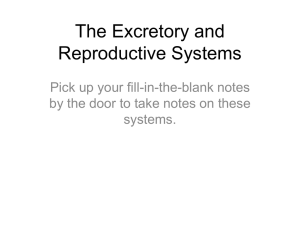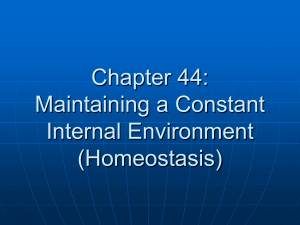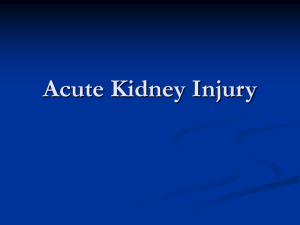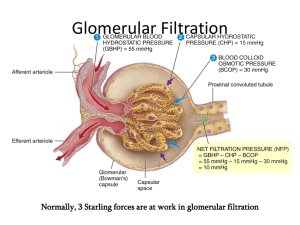PPT24Chapter24UrinarySystem
advertisement
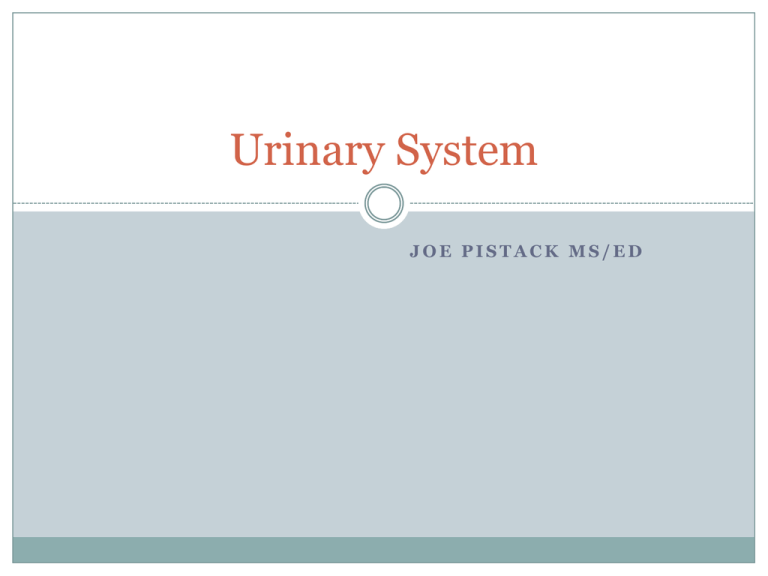
Urinary System JOE PISTACK MS/ED Urinary System Urinary System is comprised of: Two kidneys: form urine from the blood Two ureters: tubes that conduct urine to bladder from kidneys One urinary bladder: reservoir holding urine temporarily One urethra: tube that conducts urine from bladder to outside of body for elimination Kidneys: Most important excretory organs Eliminate nitrogenous waste, water, electrolytes, toxins and drugs Effectively secretes and maintains water and electrolyte balance Kidneys Location of kidneys: Located in the retroperitoneal space - posterior wall of abdominal cavity Renal fascia hold the kidneys in place Structure of kidneys: Reddish-brown bean-like structures enclosed in a tough fibrous capsule 4 inches long, 2 inches wide and 1 inch thick Structure of Kidney Structure of kidney: Three distinct regions: Renal cortex: lighter outer region Renal medulla: darker triangular portion located deeper within Forms striped cone-shaped regions called renal pyramids Renal pelvis: basin that collects urine made by the kidneys helps form the upper end of the ureter Cup-like edges, closest to pyramids are calyces which collect urine formed in the kidneys Blood supply to Kidney Blood supply to kidney: Oxygenated blood is supplied by the renal arteries Blood leaves the kidneys through several veins that finally merge at the renal vein and empties directly into the IVC Function of Kidneys Function: Kidneys cleanse the blood of waste products Help regulate volume by determining the amount of water excreted Excrete nitrogenous waste such as urea, ammonia and creatinine Helps regulate electrolyte content of blood Regulates BP through the secretion of renin Regulates RBC production through the secretion of erythropoietin Nephron Unit Nephron is the functional unit or the urine making unit of the kidney Each kidney contains about 1 million nephron units We are born with a certain number of nephrons which are not replaced if damaged Neprons contains two parts: Renal tubule Blood vessels Renal Blood Vessels Kidney receives blood from the renal arteries which branch off, each branch being smaller and smaller, creating afferent arterioles The afferent arterioles branch into a cluster of capillaries called glomerulus The glomerulus sits in Bowman’s capsule and exits from Bowman’s capsule as the efferent arteriole The efferent arteriole then form a second capillary network called peritubular capillaries Peritubular capillaries empty into venules then larger veins until finally the renal vein Renal Tubules Consist of a number of tubular structures. Bowman’s capsule C –shaped structure that partially surrounds the glomerulus. Renal Tubules Bowman’s capsule extends from the glomerulus as a coiled tube called the proximal convoluted tubule. Proximal convoluted tubule dips toward the renal pelvis to form a hairpin-shaped structure called the loop of Henle. Renal Tubules The loop of Henle contains a descending and ascending limb. The ascending limb becomes the distal convoluted tubule. The distal convoluted tubules merge to form a collecting duct. Renal Tubules The collecting duct runs through the renal medulla to the calyx - a collecting area that empties into the renal pelvis. Renal Blood Vessels Kidney receives blood from the renal artery. Renal artery branches into smaller blood vessels that form the afferent arteriole. The afferent arteriole branches into a cluster of capillaries called a glomerulus. Renal Blood Vessels The glomerulus sits in the Bowman’s capsule and exits the Bowmen’s capsule as the efferent arteriole. The efferent arteriole forms a second capillary network called the peritubular capillaries. Peritubular capillaries empty into venules, larger veins then the renal vein. Urine Formation Urine is formed by three processes: Glomerular filtration: causes water and dissovled substances to move from capillaries(glomerulus) into tubules. Tubular reabsorption: causes water and select substances to move from the tubules into the peritubular capillaries. Tubular secretion: causes the small amounts of specific substances to move from the peritubular capillaries into the tubules. Glomerular Filtration Urine formation begins in the glomerulus and Bowman’s capsule. Glomerular filtration causes water and dissolved substances to move from the glomerulus into Bowman’s capsule. Glomerular Filtration Filtration occurs when pressure on one side of a membrane is greater than the pressure on the opposite side. Blood pressure in the glomerulus is higher than the pressure in Bowman’s capsule. The difference in pressure is glomerular filtration pressure. Glomerular Filtration The wall of the glomerulus contains pores and acts like a strainer. Size of the pores determines which substances move across the wall from the glomerulus into Bowman’s capsule. Small substances such as water, glucose, chloride, and potassium move across easily. Large molecules such as RBC’s, and large proteins cannot fit through the pores and remain in the glomerulus. Glomerular Filtration The water and dissolved substances are called glomerular filtrate. Glomerular filtration rate-(GFR)-is the rate at which glomerular filtration occurs. Usually 125ml/min, or 180L in 24hrs. We excrete about 1.5L/day. Urine Formation Tubular reabsorption is the reabsorption of filtrate by the kidneys which is returned to circulation It is the process by which water & dissolved substances move from the tubules into the blood of the peritubular capillaries Most reabsorption occurs in the proximal convoluted tubule The kidney determines what is excreted & what is reabsorbed: Creatine is not reabsorbed 50% of urea is absorbed All of glucose is reabsorbed 99% of water & sodium are reabsorbed Reabsorption occurs either passively or actively Sodium is actively transported Water & chloride passively follow sodium Diuretics affect sodium tubular reabsorption which causes water & sodium excretion causing diuresis Hormone Control of Water & Electrolytes Several hormones act on the kidneys to regulate water & electrolyte excretion Play important role in regulation of BP, blood volume & electrolyte composition of body fluids Included are: Aldosterone Antidiuretic Hormone (ADH) Atrial Natriuretic Factor (ANF) Parathyroid Hormone (PTH) Tubular Reabsorption Most of the filtrate is reabsorbed in the kidney and returned to the circulation. Tubular reabsorption is the process by which water and disolved substances move from the tubules into the blood of the peritubular capillaries. Most reabsorption occurs in the proximal convoluted tubule. Tubular Reabsorption Absorption is either active or passive. In general, when sodium is pumped from one location to another , water follows passively. Most diuretics block the tubular reabsorption of sodium and therefore block the reabsorption of water. Excess water and sodium remain in the tubules and are eliminated as urine. Tubular Secretion Tubular secretion-moves small amounts of substances from the blood into the tubules. Several hormones act on the kidney to regulate water and electrolyte excretion. Aldosterone-secreted by the adrenal cortex. Acts primarily on the distal tubule of the kidney. Stimulates the reabsorption of sodium and water and the excretion of potassium. Tubular Secretion Aldosterone increases blood volume, increases blood pressure. Deficiency of aldosterone can cause decrease in blood pressure and result in shock. Renin is an enzyme that causes the release of aldosterone. Aldosterone Renin-angiotensin-aldosterone system: Renin-secreting cells are stimulated when blood pressure or blood volume declines. Renin activates angiotensin to form angiotensin I Converting enzyme acts to change angiotensin I to angiotensin II. Angiotensin II stimulates adrenal cortex to release aldosterone. Hormones The aldosterone in return, stimulates the distal tubule to reabsorb sodium and water and to excrete potassium. Angiotensin II is a potent vasopressor, causes vasoconstriction and an elevation in blood pressure. Antidiuretic Hormone-hormone that affects water reabsorption. Works primarily on the collecting duct by determining it’s permeability to water. Hormone Control Atrial Natriuretic Peptide Causes the excretion of sodium Called natriuresis ANF is secreted by the walls of the atria in response to an increase in the volume of blood ANF decreases the secretion of aldosterone by the adrenal cortex which decreases sodium & water reabsorption ANF has the opposite effects of aldosterone & ADH Hormone Control Parathyroid Hormone: Secreted by the parathyroid glands Plays important role in the regulation of 2 electrolytes, calcium & phosphate PTH stimulates the renal tubules to reabsorb calcium & to excrete phosphate The excretion of phosphate is called phosphaturic effect Stimulus for the release of PTH is low plasma levels of calcium Urine Sterile Composed of 95% water Light yellow color is due to a pigment called urochrome, formed by breakdown of hemoglobin in the liver. Urine Average output is 1500ml/24hrs. Specific gravity-1.001 to 1.035. Renal Failure Renal failure occurs when the kidneys no longer make urine. The result is the blood is not cleansed of its waste so they remain in the blood causing uremia. Uremia requires an artificial kidney in the form of dialysis. The patients blood is passed through a cylinder containing tiny tubes immersed in dialysate . The dialysate cleanses the blood of waste products & the blood is then returned to the patient. Renal Failure Another procedure used in renal failure is peritoneal dialysis. The peritoneal cavity is infused with dialysate. The waste diffuse from the blood into the dialysate & then the dialysate is drained & discarded. Urinary Tract Urinary system is composed of structures that compose the urinary tract These structures simply store or conduct urine from the kidney to outside the body The urinary tract is comprised of: Inner layer is a mucous membrane Middle layer is smooth muscle Outer layer is connective tissue Structures include: Ureters Urinary bladder Urethra Urinary Tract Ureters: Two ureters connect the kidneys to the bladder The ureters originate in the pelvis of the kidneys & terminate in the bladder 10-13 inches in length They are slender muscular tubes that propel urine by peristalsis & gravity Urinary Tract Urinary Bladder Temporary reservoir to store urine Made up of 4 layers: Innermost is mucous membrane with transitional epithelium Second layer is submucosa is made of connective tissue & elastic fibers Third layer is smooth muscle called detrusor muscle Outermost layer of upper is serosa & lower portion is covered by connective tissue Bladder wall is made up of rugae which are folds that allow the bladder to expand & stretch The urge to urinate usually occurs when 200ml have accumulated Trigone is a triangular area of the bladder which forms as the entrance point for two ureters & the exit point for the urethra The exit of the bladder contains the internal sphincter which is composed of smooth muscle that contracts involuntarily to prevent emptying The external sphincter surrounds the upper region of the urethra, is composed of voluntary skeletal muscle & contraction allows us to resist urination Urination Urination: micturition or voiding Process of expelling urine from the bladder As the bladder fills, stretch receptors are stimulated sending a nerve impulse through sensory nerves to the spinal cord; the spinal cord sends reflex motor nerve impulse back to the bladder causing the bladder wall to contract rhythmically & the internal sphincter relaxes Called micturition reflex The reflex gives rise to a sense of urgency & the external sphincter prevents involuntary urination Inability to empty bladder is urinary retention Urinary Tract Urethra: Tube that carries urine from the bladder to the outside Lined with mucous membrane that contains numerous mucussecreting glands The muscular layer of the urethra contracts & helps to express urine during urination Males urethra is about 8 inches & is part of the reproductive system as well Female urethra is about 1.5 inches The opening of the urethra to the outside is called the urethral meatus
